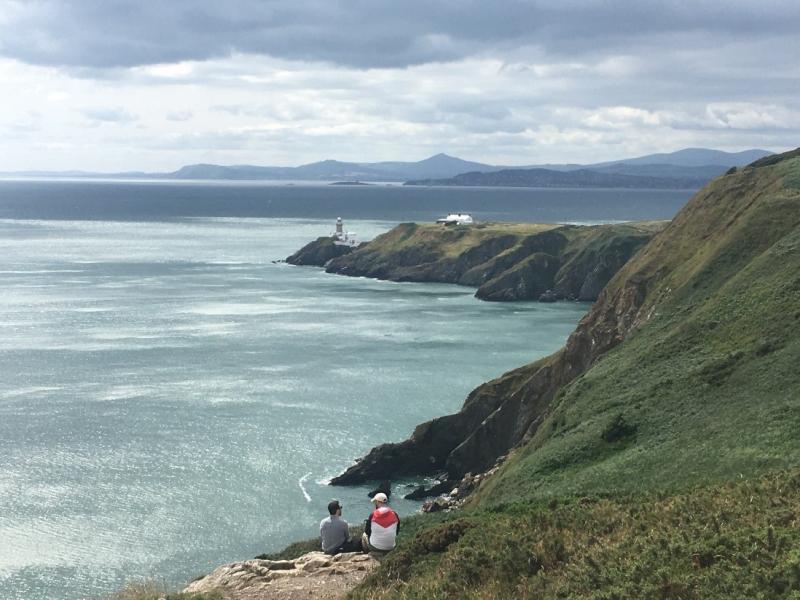The Curious Name of King Crimthaind
According to both medieval manuscripts and local lore, Howth was once ruled over by the legendary King Crimthaind. He was said to have resided in a fort overlooking the sea which he built after returning from a journey to the magical Otherworld. A place lore poem titled Dun Crimthaind describes his journey and the treasures he acquired while in the Otherworld:
I brought away the horned polished beaker
of Tuathal across the salt of the ocean-road;
15] thrice nine draughts, that was its content,
he pressed from a single grain, — goodly its metal.
I brought the chess-board of white-skinned Guaire
from the waves of ocean, with numbers of exploits;
there was not found under heaven a treasure to surpass it,
20] wherein are three hundred bright gems.
I brought the shirt of fierce Lug
to my country from the water of the Irish sea;
all of refined red gold,
that was inwoven7 from bridle to head.
I brought the fierce flashing sword
of Congal, author of dreadful havoc;
it was a treasure of the kings of Inis Fail,
a hundred golden snakes along its blade.
I brought a shield that was Daire Derg's
30] from the field where spear-casts wounded men: —
thrice nine arrows of pale silver
round the rim wrought by the graver's tool.
(Dun Crimthaind, Metrical Dindshenchas)
King Crimthaind’s full title is Crimthaind Nia Nár meaning Crimthaind the champion of Nár. Nár was an Otherworld woman who accompanied Crimthaind on his journey and in another version of the poem, it was Nár who gifted Crimthaind with the treasures listed above (Dun Crimtainn, Rennes Dindshenchas). Crimthaind is recorded in medieval sources as ruling Howth for 16 years until he was thrown from his horse and died (AFM: M1.0; M9.1; Resurrecting Monuments 2019: 41). A cairn located in the valley between Shielmartin, and Dun Hill is believed by some to mark his final resting place (McBrierty 1981: 5).
The lack of certainty surrounding the final resting place of Crimthaind extends to the location of his famous fort called Dun Crimthaind after him. Medieval sources describe the fort as being visible from Meath leading some to suggest it was situated at either Tower Hill or Dunbó Hill overlooking the area of Howth Harbour today (Westropp 1922: 57; McBrierty 1981: 5). However, there is also a strong local tradition that the fort is located on a headland projecting into Doldrum Bay where the Bailey Lighthouse now stands. Maps from the 17th century name this site as Dun Griffen (an anglicized form of Dun Crimthaind) while archaeological research has confirmed the presence of a coastal promontory fort here. The fort today called the Dungriffin promontory fort is one of several dotted along the Dublin coastline believed to have been used to control access into Dublin Bay (Mongey 2018: 41). These forts are located on Dalkey Island, Lambay, Shenick’s Island, Howth and at Loughshinny. They not only share morphology but material culture with Roman artefacts having been found at each of these places suggesting contact between them and Roman Britain (Cahill Wilson et el 2021: 93; Mongey 2018: 44).
The name Crimthaind given to both the famous king and his fort is explained in medieval sources as fox providing a curious link to some of the other coastal promontory forts (dil.ie/12943; Carmody 2015). Drumanagh is the name of the fort located in Loughshinny which in Irish is Loch Sionnaigh meaning the lake/inlet of the Foxes (www.logainm.ie/ga/1166408; NMR: DU00837). Another of these forts is located on Shenick’s Island or Oileán Sionnaigh in Irish meaning the Island of the Foxes (www.logainm.ie/17033; NMR: DU005116). These promontory forts linked by morphology, material culture and placenames suggest a connectivity of culture between them. The figure of King Crimthaind who is intrinsically tied to Howth bears a name linking him into this culture which in turn suggests the Dungriffin coastal promontory fort as the famous Dun Crimthaind.
Want to Delve Deeper?
To read the full version of Dun Crimthaind click here. To find out more about the coastal promontory forts of Fingal check out this digitised report by the Discovery Programme’s Late Iron Age and Roman Ireland Project. To find out more about archaeological fieldwork undertaken at sites in Fingal such as Dungriffin promontory fort check out the Facebook page of Resurrecting Monuments a community archaeology group active in the area.
-Aoife Walshe.
Bibliography
Annals of the Four Masters, accessed through https://celt.ucc.ie//publishd.html
Cahill Wilson, Jacqueline; Dowling, ger; Bevivino, Michael Ann (2021), ‘’Investigations on Lambay Co. Dublin’’, Late Iron Age and Roman Ireland, Discovery Programme Reports: 8, Dublin, 91-113.
Carmody, Isolde (2015), ‘Notes on Names and Places’, accessed through https://storyarchaeology.com/the-poems-of-sinann-2.
Dowling, Ger, (2021), ‘’Geophysical Investigations at Drumanagh and Loughshinny, north County Dublin’’, Late Iron Age and Roman Ireland, Discovery Programme Reports: 8, Dublin, pp. 59-91.
d. crimthainn, Onomasticon Goedelicum: An index, with identifications, to the Gaelic names of places and tribes, Edmund Hogan, SJ, accessed through: http://publish.ucc.ie/doi/locus
Dun Crimthaind, Poem 16, Metrical Dindshenchas, trans. Gywnn, Edward, accessed through; https://celt.ucc.ie//published/T106500C/index.html.
Dun Crimthann, The Prose Tales in the Rennes Dindshenchas, Trans. Stokes, Whitley, accessed through https://www.ucd.ie/tlh/trans/ws.rc.15.001.t.text.html
Historic Map 6 inch Black & White (1837-1842), accessed through http://map.geohive.ie
McBrierty, Vincent (1981), The Howth Peninsula: Its History, Lore & Legend, Dublin.
Mongey, Mick (2018), ‘Dublin’s Forgotten Fort’, Archaeology Ireland, (Vol. 32:2), pp. 40-44.
National Monuments Records, accessed through https://maps.archaeology.ie/historicenvironment.
O hOgain, Daithi (1991), Myth, Legend & Romance: An Encyclopedia of the Irish Folk Tradition, England.
Placenames Database of Ireland, accessed through https://www.logainm.ie/ga/
Resurrecting Monuments (2019), A Guide to the Archaeology of the Howth Peninsula: The Story of Howth and its People, Dublin.
Westropp, T.J. (1922), ‘The Promontory Forts and Adjoining Remains in Leinster Part 1 Co. Dublin’, The Journal of the Royal Society of Antiquaries of Ireland, (Vol. 12, No. 1), pp. 52-76.
